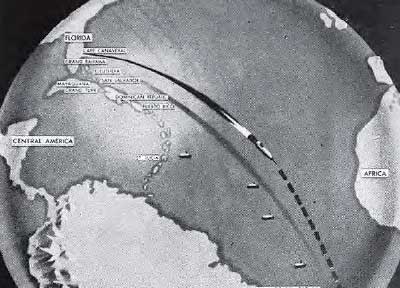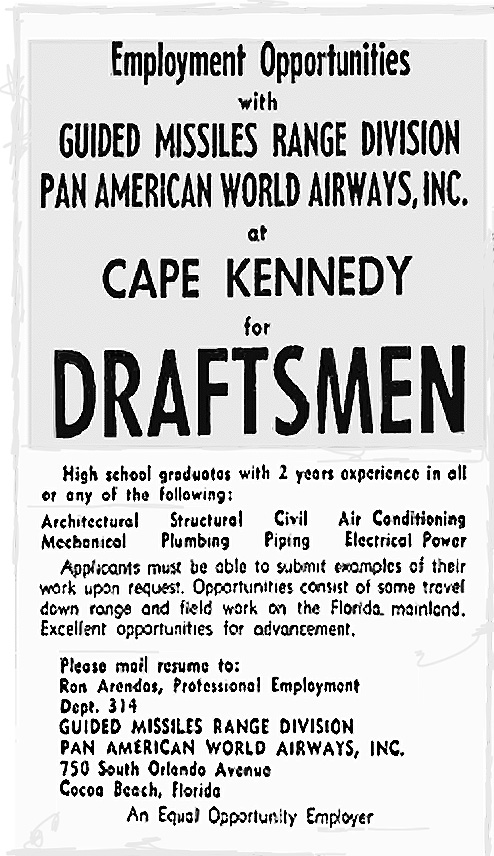Pan Am & The Race to Space
Over the course of six-plus decades Pan Am, the airline, proved that it could maintain routes to far-flung places around the globe. Most people naturally associate this heritage with generations of human-operated, winged “air-breathing” sorts of “vehicles” - and that’s true, but not strictly speaking, the entire story.
In 2001: A Space Odyssey filmmaker Stanley Kubrick tickled imaginations with a shot of a Pan Am-liveried space plane, and it’s cabin filled with very relaxed and weightless passengers. But that was fantasy.
In reality, although Pan Am didn’t make it into space, it certainly helped us get there. That’s worth remembering now, decades after anyone from this planet visited our nearest inter-planetary neighbor, the Moon.
As it happens, thanks to a national imperative resulting from an anything-but-relaxed global arms race, Pan Am was deeply involved in America’s move towards space, beginning in the 1950’s. The company was a prime contractor to the U.S. Air Force, and was instrumental in operating what became known as the Eastern Missile Test Range, as well as other facilities dedicated to America’s space efforts.
With the close of WWII, it was obvious to America’s military strategists that there would be keen global competition with the Soviet Union over the “high frontier” of space. Both sides had rushed to capture former Nazi rocket scientists and hardware as the Third Reich collapsed, and the race was on. In the U.S. a joint committee of civilian and military leaders reviewed possible sites for long-range missile proving grounds, and they found an ideal spot on the isolated east coast of Florida. The Air Force was given managerial responsibility for an abandoned naval facility, which became the heart of the Air Force Eastern Test Range (AFETR). In 1950, the newly re-purposed facility became Patrick Air Force Base. 15 miles to the north was Cape Canaveral Air Force Station, where the launch facilities were placed. To the east, stretching out over the Atlantic, was the missile testing range.
 The Eastern Missile Test Range. Courtesy of HathiTrust.org, "Conquest of the Air: The History and Future of Aviation" by Hendrick de Leeuw, 1960.
The Eastern Missile Test Range. Courtesy of HathiTrust.org, "Conquest of the Air: The History and Future of Aviation" by Hendrick de Leeuw, 1960.
As the U.S. defense establishment developed increasingly complicated missiles, the effort demanded better coordination of a range of technologies, products, and the vendors that supplied them. To better accommodate this process, the government decided to contract out the oversight of the operation. Early on in President Eisenhower’s first term, operational management of the Air Force missile testing facility was turned over to Pan American World Airways, which in turn sub-contracted RCA for certain services. In late 1953, the airline created a brand new division to oversee the work, known as the Guided Missiles Range Division, or G.M.R.D.
The missiles - developed and launched by various “clients” including the U.S. Air Force, Navy, and Army; as well as civilian agencies and even some foreign nations such as the United Kingdom - lifted off from Florida and were tracked on their flights by a series of tracking stations, on both land and sea.
The original emphasis was on defense-related technology, but after President Kennedy declared on September 12, 1962 that the U.S. would try for the Moon, (listen or read the transcript at NASA: John F. Kennedy Moon Speech - Rice Stadium) there was increasing focus on manned space flight. The missile test range, which was at first only a few hundred miles, kept growing. By the mid-sixties, it extended to the Indian Ocean.
The technological “envelope” that made this work possible can be inferred from the want ads placed by the Guided Missiles Range Division in engineering magazines. One ad made it plain that that successful candidates would “do much more than watch.” They would be “helping to engineer tracking, telemetry, communications, data handling and display systems.” They might also find work providing “launch and base support operations for many of the nation’s major space shots along the 10,000 miles of the Eastern Test Range from Cape Kennedy to the Indian Ocean.” The ad promised that new hires would “soon find that you’re equally comfortable with a wide range of specialties: radar, telemetry, electrical, optics, command/control, timing, hydraulics, statistics, infrared, orbital, mechanics, structures, aeronautics, instrumentation, communications, etc”. Obviously, getting to space required the GMRD to have access to and deploy people with myriad advanced skills and knowledge sets.
Ad in the Daytona Beach Morning Journal, February 9, 1964.
In retrospect, there was some criticism of the political propriety surrounding the awarding of the contract to Pan Am, as well as some grumbling about the efficiency of the operation, but the GMRD proved itself as the years went by and even critics admitted that Pan Am’s management at the Cape had become efficient and effective. The scope of operations at the Cape included storing and transporting missile fuel, launch pad safety, coordination of all range support during missile tests, analyzing mechanical or electrical failures at missile complexes, and providing the security as well as fire and medical services. Not least, Pan Am was responsible for the commissary services at the Cape, too. By 1961, the GMRD was earning Pan Am $90 million a year in revenue.
The pace of space and missile development grew in the 1960’s, and new contracts for facilities in Arizona and Canada were awarded to Pan Am. The seagoing tracking platforms operated by the company were upgraded too. By 1967, the GMRD had outgrown it’s original mission, and was renamed the Aerospace Services Division. In 1980, this Pan Am subsidiary was made part of Pan Am World Services, a diversified and far-ranging part of Pan Am, which included the Falcon Business Jet division.

Ad from 1968 — The Pan Am Guided Missile Range Division had grown.
In succeeding years, Pan Am’s aerospace services subsidiary remained an unfailing bright spot on the balance sheet of the airline, even as other factors worked to darken Pan Am’s skies. Towards the end of Pan American’s corporate life, the Aerospace Services Division was sold off, (to operate as Johnson Controls) but the cash infusion wasn’t enough to stem the bankruptcy of Pan American World Airways at the end of 1991. Like some other of Pan Am’s business ventures, such as Intercontinental Hotels, and the Pan Am Flight Academy, the Aerospace Services Division lives on as a different entity, reborn but continuing a legacy that owes a lot to the World’s Most Experienced Airline.





